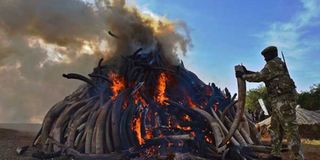Don’t burn tusks; sell them cheaply to beat poachers and save elephants

A 15 tonne pile of ivory burning at the Nairobi National Park on March 3, 2015. PHOTO | CARL DE SOUZA |
What you need to know:
- A friend was not particularly impressed with the torching of elephant tusks and rhino horns.
- His solution is to create “cheap ivory and horn”.
President Uhuru Kenyatta on Tuesday set ablaze 15 tonnes of elephant tusks and rhino horns — a pile that was three metres high — at the Nairobi National Park in a move to protect the country’s wildlife.
The government plans to burn the rest of its ivory stockpile later this year, Mr Kenyatta said.
African elephants are considered endangered, with about 470,000 left in the wild in 37 countries, according to the African Wildlife Foundation.
Poaching of the animals, which is reducing their population faster than they can reproduce, is worth as much as $188 million a year, United Nations Congress on International Trade in Endangered Species of Wild Fauna and Flora figures show, according to a Bloomberg report.
The report added that poachers killed 164 elephants in Kenya last year, compared with 302 in 2013 and 384 in 2012, while 53 rhinos were killed in 2014 compared with 59 and 30 in the previous two years, citing the Kenya Wildlife Service.
The Kenyan government partly attributes the reduction in poaching to tougher laws enacted last year, Paul Muya, deputy spokesman for the service, told Bloomberg.
“Burning of contraband ivory, coupled with China stopping importing ivory for one year starting last week, will help greatly in the fight against poaching,” Muya said.
In 1989, former Kenyan president Daniel arap Moi burned 12 tonnes of ivory worth more than $1 million at the Nairobi National Park.
Kenya’s elephants were on the brink of extinction at the time, with the population having dropped to 16,000 from 167,000 in 1973. This halted the decline in the elephant numbers, which currently stands at about 38,000.
In 2009, former President Mwai Kibaki burned five tonnes of tusks that were traced to Singapore and returned, according to Muya.
Kenya may have as much as 100 tonnes of contraband ivory in its stockpiles, according to Paula Kahumba, chief executive officer of WildlifeDirect, a Nairobi-based non-governmental conservation organisation.
So far, so good. With my environment and elephant-loving swag, I later went to meet a friend for coffee. He loves nature too, but only if it makes dollar sense.
FLOOD THE MARKET
He was not particularly impressed with this torching of elephant tusks and rhino horns because, he said, it takes away the best “market-based” opportunity to deal poaching a blow.
His solution is to create “cheap ivory and horn” because, he argued, poachers are primarily motivated by the returns. As long as tusks and horns fetch good money, the poachers — and their godfathers up the food chain — will think it is worth the risk of being shot to death by game warders.
The high price of tusks also means that the accessories that they make in Asia are generally expensive. Like diamonds and other precious stones, a necklace made of ivory is treasured because it is more expensive than the one made from plastic, clay, and wood.
The day it becomes cheap enough for a Chinese househelp to also afford it, just like her employer, who is a top Communist Party official, then the big woman will stop buying it and soon demand for ivory to make it will dwindle.
The way to do that is to flood the market with all the confiscated tusks. That way the elephants that the poachers kill do not die in vain. Their tusks actually go towards making them less profitable, thus they will save future elephants.
I protested, but he brought up the case of what anti-drug enforcement authorities do in the US and parts of Latin America. I told him that in the US, they destroy the drugs, which is equivalent to ivory. Ivory, he said, is a raw material. That is, no one actually wears a tusk around his neck. Drugs are an end product in themselves, which people consume.
The better argument, he said, was to look at what the Americans do with the things drug lords love to buy with the proceeds from drugs — expensive sports cars, yachts, mansions, and private jets.
He said they sell these at knockdown prices. You really cannot go around destroying a $250,000 Ferrari; it does not make sense.
This has not stopped the drug trade, but it has forced drug lords into less lethal business — smuggling mobile phones, he said. I was not convinced, but I like brave men like him who are not afraid of exploring forbidden thoughts. I paid for the coffee.
The author is editor of Mail & Guardian Africa. Twitter:@cobbo3





